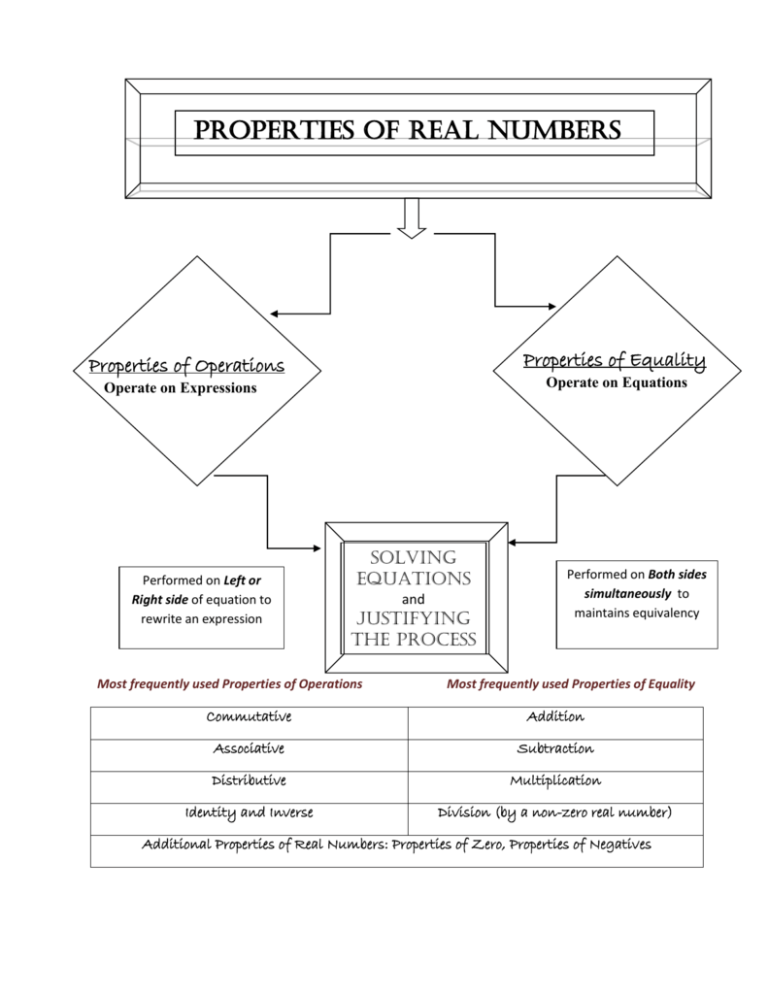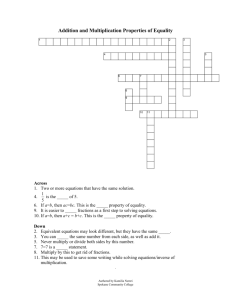Math Grade HS Reasoning with Equations
advertisement

PROPERTIES OF REAL NUMBERS Properties of Equality Properties of Operations Operate on Equations Operate on Expressions Performed on Left or Right side of equation to rewrite an expression Solving Equations and Justifying the process Most frequently used Properties of Operations Performed on Both sides simultaneously to maintains equivalency Most frequently used Properties of Equality Commutative Addition Associative Subtraction Distributive Multiplication Identity and Inverse Division (by a non-zero real number) Additional Properties of Real Numbers: Properties of Zero, Properties of Negatives I. Equation Solving First Steps Reasoning about the Equation Solving Process 1. Consider how to create a simpler equivalent equation from the given equation below. List some ways you are considering here: 2. Turn and talk with a partner. Be prepared to share out with the class. 3. Solve the given equation by the process of creating simpler equivalent equations. Write each new equivalent equation in the left column and your justification for it in the right column. Justifications can be naming the property you applied or describing the action or operation you applied. Equation to solve 7(x + 1) – 4(5 -2x) = - 5(x – 9) Justification Given Equation 4. Take the First Step: Write the first step you would take to solve each equation below. Do not solve completely. Be prepared to discuss your first step with the class. a) d) 5 3 w = 11 4 10a = 6 +2(5a – 1) b) 19z -10 + 4z = 3z – 4 e) 8x - 12 = 4( x – 3) + 4x 1 (x – 1) 2 c) 5(x + 3) = f) -2a – 4 = 6(1 – a) -1 Applications Create an equation to model the situation. Then solve the equation to find the solution: 1. The lengths in meters of the sides of a triangle are three consecutive even integers whose sum is 154 more than the greatest integer. What is the perimeter of the triangle? 2. A man has lived a fifth of his life as a boy, a fourth as a young man, a half as a married man, and has been a widow for 3 years. How old is he? II. Equation Solving Strategies Constants and variable terms a) Solve the equation 3g – 70 = 10g -7. Show the steps in your solution process. b) Compare your solution process to the 3 different solution processes in the table below: Student 1 Student 2 Student 3 3g – 70 = 10g – 7 3g – 70 = 10g – 7 3g – 70 = 10g – 7 3g = 10g + 63 -7g – 70 = -7 3g – 70 – 10g +7 = 0 -7g = 63 -7g = 63 -7g - 63 = 0 g = -9 g = -9 -7g = 63 g = -9 a) How are the solutions similar? How are they different? How do they compare to your solution? b) How do they compare in terms of efficiency? c) Turn and share with a partner your thoughts about the similarities and differences of each. Be prepared to share your insights with the class. a) Solve the problem below and show your steps 6x – 5 + 2 (4x - 1) = -5 (2x – 3) + 6x – 7 b) Compare your solution with another student. Discuss any similarities and/or differences in your strategies. c) Consider this solution by another student: 6x – 5 + 2 (4x - 1) = -5 (2x – 3) + 6x – 7 6x – 5 + 8x - 2 = - 10x + 15 + 6x - 7 6x + 8x + 10x – 6x = 15 – 7 + 5 + 2 18x = 15 x 15 5 or 18 6 d) How was your solution similar and/or different? e) What was this student’s strategy? Turn and share your thoughts with a table partner. Be prepared to share with the class. Considering Structure in the solutions of Equations: a) Solve the equation 7 (3x – 8) = 14? Show the steps that lead to your solution. b) Compare the Student solutions in the table below to your solution. Describe the first step by each student below in terms of the property applied. Student 1 Student 2 7 (3x – 8) = 14 7 (3x – 8) = 14 21x -56 = 14 3x – 8 = 2 21x = 70 3x = 10 x = 10/3 x = 10/3 c) How did the use of the structure of the equation show in Student 2’s solution? d) How do the two solutions compare in terms of efficiency? Compare the solutions by two students in each of the following problems. Student 1 1. Student 2 Student 1 2. 4(x – 1) + 3 (x -1) = 7 Student 2 2 3 (x + 5) + (x + 5) = 7 5 5 4x – 4 + 3x – 3 = 7 7(x – 1) =7 2 3 x+2+ x+3=7 5 5 x+5=7 7x – 7 = 7 x–1=1 x+5=7 x=2 7x = 14 x=2 X=2 x=2 How was structure used by Student 2 to solve each equation? What was efficient about the solutions? Find the solution to the following equations. Plan your strategy and be prepared to discuss it. 1. 12z -15z -8 + 6 = 4z + 6 -1 2. -9m – (4+ 3m) = - (2m – 1) -5 3. 1 1 ( x 3) (5 x 4) 2 2 Writing prompt. Suppose you have to help a new student to solve linear equations. Explain in your own words the process for finding the solution to a linear equation. III. Further reasoning with Equations For the equations below, replace each ? with a number or an expression so that each of the following conditions are satisfied. a) The solution is 2 b) The equation is an Identity c) No solution 1. 4 – (t – 2) = __? __ a) b) b) d) 2. – 7x + __?__ = 3x -7 c) b) d) The solution is 0 d) d) 3. Turn and talk to a partner and discuss the strategies you used to satisfy each of the conditions above. What condition(s) was the easiest to satisfy? What condition(s) was most difficult to satisfy? ` RULES GONE WILD EXPOSING FAULTY REASONING PROOF THAT 2 = 1: Study the proof below. Compare the statements and reasons in column 2. Then answer the questions below. Statement Property 1. a = b 1. You are given that two numbers called a and b are equal 2. a2 = a b 2. Multiplication Prop. of Equality 3. a2 - b2 = a b - b2 3. Subtraction Prop. of Equality 4. (a - b)(a + b) = b (a - b) 4. Distribution (Reversed) 5. a + b = b 5. Division 6. b + b = b 6. Substitution 7. 2b = b 7. “Combine like terms” (By Distribution: b + b = b ( 1 + 1) = b(2) = 2b 8. 2 = 1 8. Division Prop. of Equality Can you find the flaw in the reasoning? Consider both the statements and the reasons. Discuss your thoughts with your group . ` Error Analysis Some of the problems below have errors. Some do not. Determine which have errors and which do not. You will then work with a small group to compare your results. For any discrepancies among your work you will need to come to a consensus. As a group you will pass in your results with corrections made and justified. 1 7 x 1 2x 5 2 7 x 2x 6 2 7x 4x 6 3x 6 2 12 x 20 4 x 16 16 x 4 x x 2 2( x 3) 3( x 1) 2 x 6 3x 3 3 5 3.1 x 2 1.5 x 5.2( x 2) 1.5 x 2.1( x 2) 15 x 21x 42 36 x 42 7 x 6 6 5( 2 x ) 3 2 x 7 3 x 5 9 5( x 4) 5 x 12 5 x 20 5 x 12 5 x 5 x 32 1 4 4 5 x 6 3 5 x 9 x 4(3x 5) 2( x 8) 6 x 12 x 20 2 x 16 6 x 10 5 x 5 x 10 5 x 5 x xx 0 x 32 x 32 No Solution Find the lengths of the sides of the triangle if the perimeter is 3 times the length of side AC A 11 - x 3x – 2 B x+2 C











